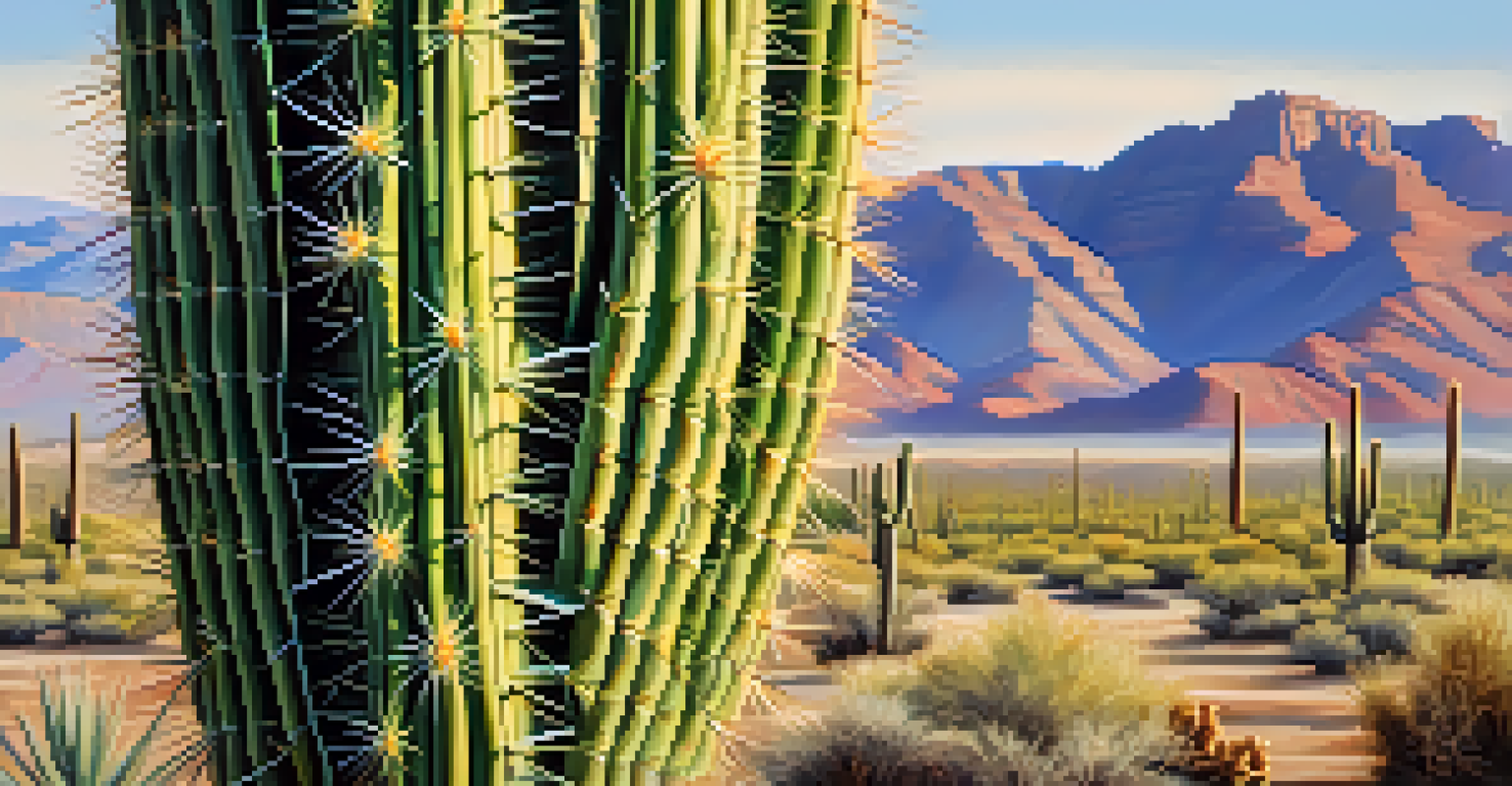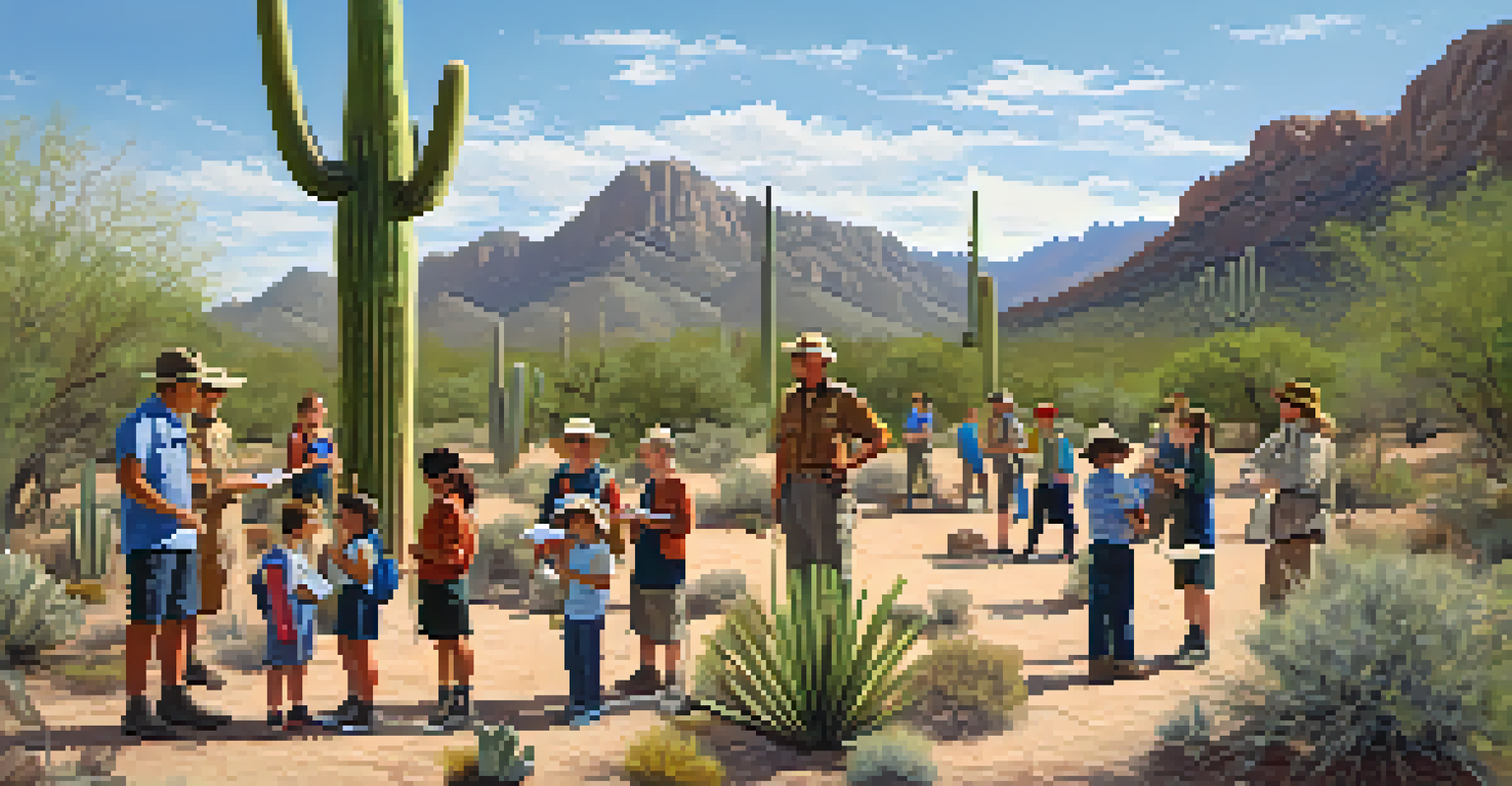Impact of Tucson on Saguaro National Park Conservation

Understanding Saguaro National Park's Importance
Saguaro National Park, home to the iconic saguaro cactus, spans over 91,000 acres in Arizona. This unique ecosystem is not only a symbol of the American Southwest but also a critical habitat for diverse wildlife. Protecting this park preserves the natural beauty and biodiversity of the region, making it essential for both ecological balance and tourism.
In every walk with nature one receives far more than he seeks.
Visitors flock to the park to experience its striking landscapes and learn about its rich cultural history. The park's vast desert environment plays a vital role in education, recreation, and conservation efforts. As Tucson grows, the need to safeguard this natural treasure becomes increasingly significant.
The saguaro cactus itself can live for over 150 years, making its conservation a long-term commitment. Given the impacts of climate change, urban development, and invasive species, it's crucial to ensure this landmark remains protected for future generations.
Tucson's Urban Development and Its Challenges
As Tucson continues to develop, the growth of urban areas poses challenges to Saguaro National Park. New construction projects can encroach on natural habitats, threatening both plant and animal species. The expansion of infrastructure often leads to increased pollution and disruption of local ecosystems, which is a growing concern for conservationists.

Furthermore, the rising population in Tucson places additional pressure on natural resources. Water shortages and land degradation are becoming more prevalent, impacting the delicate balance within the park. It necessitates a collaborative approach to ensure that both urban development and conservation efforts can coexist.
Importance of Saguaro National Park
Saguaro National Park is vital for preserving biodiversity, cultural history, and the natural beauty of the American Southwest.
Community awareness about these challenges is vital. Engaging residents in discussions about sustainable development can help bridge the gap between urban growth and environmental preservation, fostering a sense of responsibility towards the park.
Community Initiatives Supporting Conservation
Tucson residents and organizations have initiated numerous conservation efforts for Saguaro National Park. Volunteer programs, such as habitat restoration and clean-up events, encourage community involvement in preserving the park’s beauty. These initiatives not only enhance the park’s ecological health but also deepen the connection between locals and their natural surroundings.
The Earth does not belong to us: we belong to the Earth.
Schools and educational institutions in Tucson often partner with the park for field trips and educational programs. These experiences cultivate an appreciation for the environment among young people, fostering future generations of conservationists. By instilling a sense of stewardship in the youth, Tucson is investing in the long-term health of Saguaro National Park.
Local businesses also play a role by promoting eco-friendly practices and supporting park-related events. This collaboration helps raise awareness and funds for conservation projects, showcasing how community efforts can positively impact the park's future.
The Role of Local Government in Conservation Efforts
Local government policies significantly influence the conservation of Saguaro National Park. Zoning regulations and land use planning can help protect natural areas from overdevelopment, ensuring that the park remains an integral part of Tucson’s landscape. By prioritizing conservation in policy-making, officials can create a framework for sustainable growth.
Moreover, local government can facilitate partnerships between various stakeholders, including non-profits, businesses, and residents. These collaborations can lead to more comprehensive conservation strategies that address both ecological and community needs. Engaging the public in these discussions ensures that diverse perspectives are considered.
Challenges from Urban Development
Tucson's urban growth threatens natural habitats and increases pressure on resources, necessitating a balance between development and conservation.
Funding for conservation initiatives often comes from local government grants and support. By allocating resources to protect Saguaro National Park, Tucson’s leaders demonstrate their commitment to preserving the natural heritage that defines the region.
The Impact of Climate Change on Saguaro Cacti
Climate change poses significant threats to the saguaro cacti and their ecosystems. Increased temperatures and altered precipitation patterns can affect the growth and survival of these iconic plants. Understanding these impacts is essential for developing effective conservation strategies that can mitigate the effects of changing climate conditions.
Saguaro cacti are particularly sensitive to drought, which can stunt their growth and reproductive success. As climate patterns shift, the risk of severe droughts increases, making it vital to monitor the health of these cacti closely. Conservationists are working on strategies to enhance the resilience of saguaros against such pressures.
Community involvement in climate action can also support conservation efforts. By advocating for sustainable practices and supporting policies aimed at reducing carbon footprints, Tucson residents can contribute to the long-term health of Saguaro National Park and its iconic flora.
Educational Programs and Outreach from Tucson
Tucson offers a variety of educational programs aimed at raising awareness about Saguaro National Park's significance. Workshops, guided tours, and informational sessions help visitors and residents alike to understand the park's ecosystems and conservation needs. Education plays a crucial role in fostering a sense of responsibility towards preserving this natural treasure.
Local organizations often collaborate with the park to provide resources and training for teachers. By integrating environmental education into school curriculums, students learn about the importance of conservation from an early age. This grassroots approach empowers young people to take an active role in protecting their environment.
Community Engagement in Conservation
Local initiatives and educational programs are crucial for fostering a sense of stewardship among residents, ensuring the park's protection.
Community events centered around conservation, such as Earth Day celebrations, also serve to engage the public. These gatherings foster a sense of community while promoting the importance of protecting Saguaro National Park and its unique biodiversity.
Future Prospects for Saguaro National Park Conservation
Looking ahead, the future of Saguaro National Park conservation hinges on collaboration between Tucson residents, local government, and conservation organizations. By working together, they can develop innovative strategies that balance urban growth with the preservation of natural habitats. Engaging the community in these efforts ensures a shared commitment to protecting this vital ecosystem.
As climate change continues to pose challenges, ongoing research and monitoring will be essential. Scientists and conservationists must adapt their strategies to address the evolving threats facing the park. This proactive approach can help safeguard the saguaro cacti and the diverse wildlife that depend on them.

Ultimately, the success of conservation efforts will rely on the passion and dedication of the Tucson community. By fostering a culture of environmental stewardship, Tucson can pave the way for a sustainable future where Saguaro National Park thrives alongside its urban surroundings.